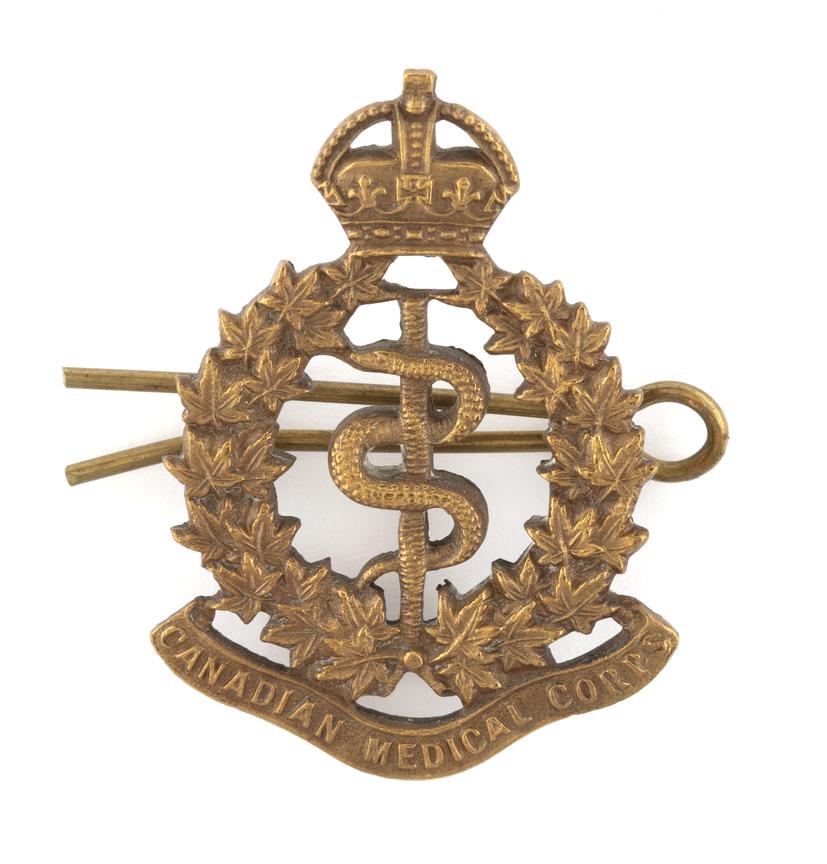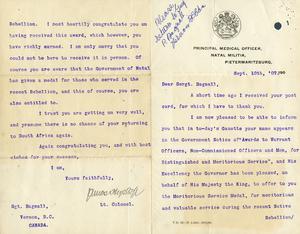Unit
No 6 Field Ambulance
Branch
Canadian Army Medical Corps
Service Component
Canadian Expeditionary Force
Service Number
46,50504
birth
1883/10/08
Dublin, Ireland
death
1983/02/02
Vernon, British Columbia, Canada
grave
Vernon Cemetery, Vernon North Okanagan Regional District
Gender
Male
Guy Pearse Bagnall was born in Dublin Ireland in 1883. There is no record of his parents or early life, although by 1915 his next of kin was a brother living in Leeds, England. In September 1901, he joined the British army to fight in the South African War and was assigned to the Royal Army Medical Corps in the 8th Division under General Rundle. At the end of his engagement in May 1903, he decided to stay in that part of the world and spent three years with the Natal Medical Corps during the native uprising in that province, for which services he was awarded the Meritorious Service Medal. He emigrated to Canada in 1906 and made his way to Vernon, British Columbia. He promptly joined the Canadian Militia in the 1st Regiment, British Columbia Horse. By 9 December 1911 Bagnall had passed his provisional Cavalry course and had qualified for Sergeant rank in the militia. At the outbreak of war in 1914 he joined 2nd Battalion, Canadian Mounted Rifles. His peacetime occupation at this point was variously listed as accountant and office manager.
Although he was part of the militia, he still needed to volunteer into the Canadian Expeditionary Force (CEF) so he attested on 9 July 1915 and shipped out to the United Kingdom. By 4 October 1915 he was assigned to the Assistant Director Medical Service Staff with the Canadian units at Shorncliffe in the United Kingdom, supporting the medical unit there. On 11 February 1916 his rank of Sergeant was made substantive and back dated to his arrival in United Kingdom. He was promoted to Sergeant Major 21 on September 1916 and then four days later appointed as a Warrant Officer. In February 1917 he was commended to the Secretary of State for War for his services in support of the war effort. In November 1917 he voluntarily reverted in rank to Sergeant to serve in the field. By 28 January 1918 he was attached to the 6th Canadian Field Ambulance, a unit of the 2nd Canadian Division, where he shows up in the muster roll published on 31 January of that year.
The unit was heavily involved in supporting the fighting that year. Initially posted in the Vimy area of the Arras region, it generally followed the 2nd Division through the German offensive of the spring through to the Amiens offensive starting in August of 1918. The War Diary noted that the field hospital and its staff were not immune to enemy action and suffered air attacks and casualties from artillery and gas attacks. The privates, employed as stretcher bearers, were particularly pressed and a number of them were awarded medals for extracting casualties under fire. The War Diary also records the efforts of a unit learning how to benefit from the new technique of blood transfusion, attempts to establish electric field generators for their field surgeries, and at least one incidence of delivering a baby at a French farm house. By 18 December 1918, Bagnall was transferred back to Shorncliffe and by 20 January 1919 was sent back to Canada on the Empress of Britain. He was discharged in British Columbia on 20 March of that year.
Initially giving his demobilization address as Vernon, British Columbia, by 1921 Bagnall had moved to Fairview, British Columbia, to run a farm. The next year he married Luta Ann Pound of Manitoba and by 1940 the couple were running a store in Yale, British Columbia. According to passenger records, Bagnall seems to have travelled quite frequently to the Western Unite States, to Hawaii, and back to the United Kingdom. He appears to have moved back to Vernon by 1949 as he and his wife are commended for establishing the local museum and archives there. He died on 2 February 1983 at the age 100 and is buried in the Vernon Cemetery in the North Okanagan Regional District.




